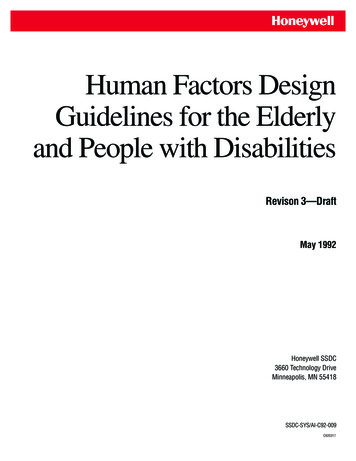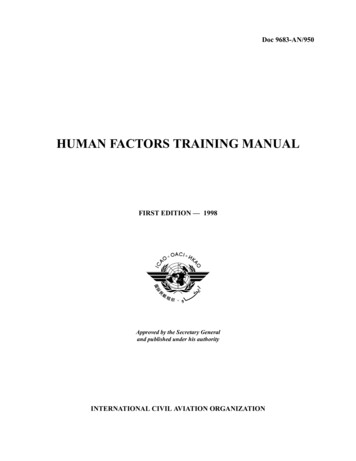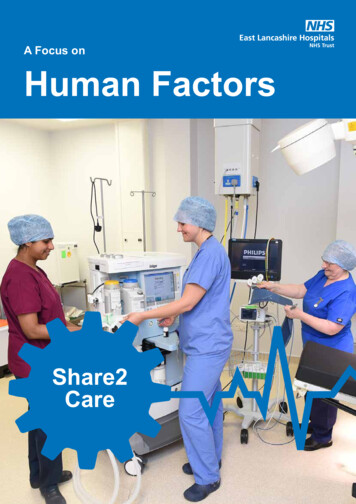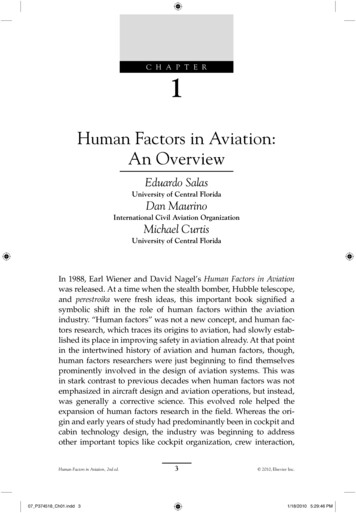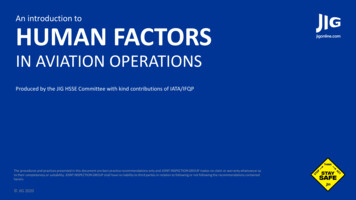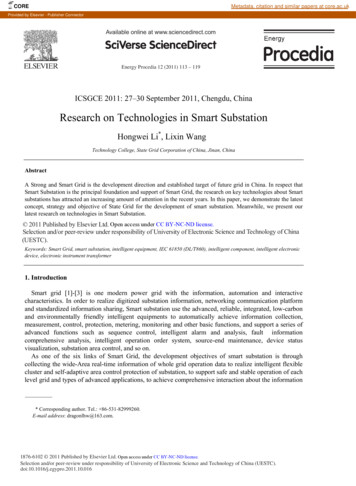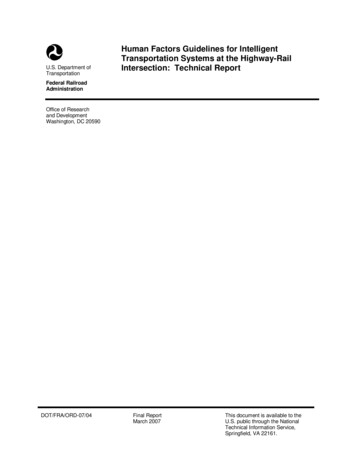
Transcription
U.S. Department ofTransportationHuman Factors Guidelines for IntelligentTransportation Systems at the Highway-RailIntersection: Technical ReportFederal RailroadAdministrationOffice of Researchand DevelopmentWashington, DC 20590DOT/FRA/ORD-07/04Final ReportMarch 2007This document is available to theU.S. public through the NationalTechnical Information Service,Springfield, VA 22161.
NOTICEThis document is disseminated under the sponsorship of theDepartment of Transportation in the interest of informationexchange. The U.S. Government assumes no liability for itscontents or use thereof.NOTICEThe U.S. Government does not endorse products or manufacturers.Trade or manufacturers’ names appear herein solely because theyare considered essential to the objective of this report.
REPORT DOCUMENTATION PAGEForm ApprovedOMB No. 0704-0188Public reporting burden for this collection of information is estimated to average 1 hour per response, including the time for reviewing instructions, searching existing data sources,gathering and maintaining the data needed, and completing and reviewing the collection of information. Send comments regarding this burden estimate or any other aspect of thiscollection of information, including suggestions for reducing this burden, to Washington Headquarters Services, Directorate for Information Operations and Reports, 1215 JeffersonDavis Highway, Suite 1204, Arlington, VA 22202-4302, and to the Office of Management and Budget, Paperwork Reduction Project (0704-0188), Washington, DC 20503.1. AGENCY USE ONLY (Leave blank)2. REPORT DATE3. REPORT TYPE AND DATES COVEREDMarch 2007Final Report 9/2001–11/20054. TITLE AND SUBTITLE5. FUNDING NUMBERSHuman Factors Guidelines for Intelligent Transportation Systems at the Highway-RailIntersection: Technical Report6. AUTHOR(S)Neil D. Lerner, James W. Jenness, Jeremiah P. Singer, Richard W. Huey, and Robert E.Llaneras7. PERFORMING ORGANIZATION NAME(S) AND ADDRESS(ES)8. PERFORMING ORGANIZATIONREPORT NUMBERWestat*1650 Research Blvd.Rockville, MD 208509. SPONSORING/MONITORING AGENCY NAME(S) AND ADDRESS(ES)10. SPONSORING/MONITORINGAGENCY REPORT NUMBERU.S. Department of TransportationFederal Railroad AdministrationOffice of Research and DevelopmentWashington, DC 20590DOT/FRA/ORD-07/0411. SUPPLEMENTARY NOTESCOTR: Dr. Thomas Raslear*under subcontract from Foster-Miller, Inc.12a. DISTRIBUTION/AVAILABILITY STATEMENT12b. DISTRIBUTION CODEThis document is available to the public through the National Technical Information Service,Springfield, VA 22161.13. ABSTRACT (Maximum 200 words)This technical report documents the development of a set of human factors guidelines to aid designers and implementers ofintelligent transportation systems (ITS) at highway-rail intersections (HRIs). The focus was specifically on roadway user humanfactors issues. In addition to providing immediate benefit, the guidelines were also designed to serve as a resource and impetusfor the development of consensus standards, approved practices, industry guidelines, and other more formal guidance. The set ofpotential human factors issues was derived from a review of existing literature and research studies, as well as contacts withexperts and ITS implementers. The guidelines document was arranged in three major sections: Section 1 introduces the majorissues and considerations that the guidelines address; Section 2 provides general human factors guidance for messages anddisplays; and Section 3 provides specific guidance for applications, including train arrival warnings, advance information aboutthe HRI, enforcement and control of vehicles, and light rail transit. Each guidelines chapter begins with an introduction to thebackground and major issues of the application. Next, a set of human factors guidelines statements is presented, along withsupporting discussion and rationales for each statement.14. SUBJECT TERMS15. NUMBER OF PAGESHuman factors, intelligent transportation systems (ITS), highway-rail intersection (HRI), gradecrossing17. SECURITY CLASSIFICATIONOF REPORT18. SECURITY CLASSIFICATIONOF THIS PAGE19. SECURITY CLASSIFICATIONOF ABSTRACTUnclassifiedUnclassifiedUnclassifiedNSN 7540-01-280-55005816. PRICE CODE20. LIMITATION OF ABSTRACTUnlimitedStandard Form 298 (Rev. 2-89)Prescribed by ANSI Std. 239-18298-102i
METRIC/ENGLISH CONVERSION FACTORSENGLISH TO METRICLENGTHMETRIC TO ENGLISHLENGTH (APPROXIMATE)(APPROXIMATE)1 inch (in) 2.5 centimeters (cm)1 millimeter (mm) 0.04 inch (in)1 centimeter (cm) 0.4 inch (in)1 foot (ft) 30 centimeters (cm)1 yard (yd) 0.9 meter (m)1 meter (m) 3.3 feet (ft)1 mile (mi) 1.6 kilometers (km)1 meter (m) 1.1 yards (yd)1 kilometer (km) 0.6 mile (mi)AREA (APPROXIMATE)21 square inch (sq in, in ) 21 square foot (sq ft, ft ) 21 square yard (sq yd, yd ) 21 square mile (sq mi, mi ) 1 acre 0.4 hectare (he) AREA (APPROXIMATE)26.5 square centimeters (cm )221 square centimeter (cm ) 0.16 square inch (sq in, in )220.09 square meter (m )21 square meter (m ) 1.2 square yards (sq yd, yd )220.8 square meter (m )21 square kilometer (km ) 0.4 square mile (sq mi, mi )222.6 square kilometers (km )10,000 square meters (m ) 1 hectare (ha) 2.5 acres24,000 square meters (m )MASS - WEIGHT (APPROXIMATE)1 ounce (oz) 28 grams (gm)1 pound (lb) 0.45 kilogram (kg)1 short ton 2,000 pounds(lb) 0.9 tonne (t)MASS - WEIGHT (APPROXIMATE)1 gram (gm) 0.036 ounce (oz)1 kilogram (kg) 2.2 pounds (lb)1 tonne (t) 1,000 kilograms (kg) 1.1 short tonsVOLUME (APPROXIMATE)VOLUME (APPROXIMATE)1 teaspoon (tsp) 5 milliliters (ml)1 tablespoon (tbsp) 15 milliliters (ml)1 liter (l) 2.1 pints (pt)1 fluid ounce (fl oz) 30 milliliters (ml)1 liter (l) 1.06 quarts (qt)1 cup (c) 0.24 liter (l)1 liter (l) 0.26 gallon (gal)1 pint (pt) 0.47 liter (l)1 quart (qt) 0.96 liter (l)1 gallon (gal) 3.8 liters (l) 0.03 cubic meter (m )31 cubic foot (cu ft, ft )31 cubic yard (cu yd, yd ) 1 milliliter (ml) 0.03 fluid ounce (fl oz)3331 cubic meter (m ) 36 cubic feet (cu ft, ft )330.76 cubic meter (m )31 cubic meter (m ) 1.3 cubic yards (cu yd, yd )TEMPERATURE (EXACT)TEMPERATURE (EXACT)[(x-32)(5/9)] F y C[(9/5) y 32] C x FQUICK INCH - CENTIMETER LENGTH 3QUICK FAHRENHEIT - CELSIUS TEMPERATURE CONVERSION F -40 -22 -4 14 32 50 68 86 104 122 C -40 -30 -20 -10 0 10 20 30 40 50 140 158 176 194 212 60 70 80 90 100 For more exact and or other conversion factors, see NIST Miscellaneous Publication 286, Units of Weights andMeasures. Price 2.50 SD Catalog No. C13 10286Updated 6/17/98ii
ContentsIllustrations .vTables . .viAcknowledgements.viiExecutive Summary tives .4Overall Approach .5Scope .6Organization of the Report .72.2.12.2Human Factors Requirements and Resources for HRI Applications of ITS .9Identification of Human Factors Issues.9Initial Outline of Human Factors Requirements for ITS at the HRI.163.Development of a Human Factors Guidance Document for HRI Applications ofITS.234.4.14.2Outside Review of the Draft Guidance Document.27Solicitation of Feedback .27Reviewer General Comments on the Guidance Document .315.5.15.2Conclusions and Recommendations.39Need and Acceptance of Human Factors Guidelines for HRI Applications of ITS .39Subsequent Steps.416.References.45Abbreviations and Acronyms .47iii
IllustrationsFigure 1. Scope of the project.6Figure 2. Guidance chapters and their interrelationship .24Figure 3. Example recommendation from section on warnings about train arrival: specificrecommendations for multiple train warnings .26Figure 4. Request for reviewers .28Figure 5. Reviewer instructions .29Figure 6. Reviewer response form .30v
TablesTable 1. Organizational outline of general human factors categories for ITS issues at the HRI .10Table 2. Consolidated human factors categories from Report for the Workshop on ITS Standardsfor the Highway-Rail Intersection .11Table 3. Keywords used in literature searches, by category .13Table 4. Web sites searched .14Table 5. Topic areas covered by relevant human factors guidelines documents.15Table 6. Outline of human factors requirements for ITS at the HRI .17vi
AcknowledgementsThis report documents the activities and findings of a project that developed human factorsguidance recommendations and supporting material to assist the designers and implementers ofintelligent transportation system applications for the highway-rail intersection. A separatedocument, titled Human Factors Guidance for Intelligent Transportation Systems at theHighway-Rail Intersection, provides the guidelines themselves. The guidelines document isavailable upon request from the project’s sponsor, Dr. Thomas Raslear(thomas.raslear@dot.gov). Westat conducted the work for the Federal Railroad Administration(FRA), as subcontractor to Foster-Miller, Inc., under contract DTFR53-00-R-00017. The reportauthors gratefully thank Dr. Raslear and the staff of the FRA Office of Research andDevelopment for its support, guidance, and critical review throughout the course of the work.The authors also wish to thank Judith Gertler of Foster-Miller, Inc., for support at many pointsduring this effort.The final set of guidance recommendations produced in this project benefited from the insightfulcomments of numerous outside reviewers. The authors deeply thank these individuals forgenerously sharing their time and critical insights. The authors also gratefully acknowledge theassistance of organizations that helped distribute the request for qualified reviewers.vii
Executive SummaryThe highway-rail intersection (HRI), where a highway and railroad tracks intersect, is a point ofpotential conflict between highway traffic and trains. In 2004, 3,133 events, 1,131 injuries, and377 fatalities occurred at HRIs in the United States. With increasing traffic on highways and onrail lines, safety and operational efficiency at the HRI are important concerns. In 1997, theNational Intelligent Transportation Systems (ITS) Program Plan identified the HRI as a locationthat could reap important benefits in safety, mobility, and productivity through the use ofinnovative communications and electronics technologies known as ITS. Like all systems, ITSmust be designed with the human user in mind. The field of human factors specificallyaddresses issues of human interaction with systems.This technical report documents the development of a set of guidelines entitled Human FactorsGuidance for Intelligent Transportation Systems at the Highway-Rail Intersection. Theguidelines have two objectives: (1) to provide preliminary guidance that would be of immediateuse to designers and implementers of ITS at HRIs and (2) to serve as a resource and impetus forthe development of consensus standards, approved practices, industry guidelines, and other moreformal guidance. The scope of the guidelines is limited to human factors issues for ITS systemsthat are applicable to roadway user safety at HRIs.The first step in guidelines development was to define the set of potential human factorsrequirements that need to be addressed through guidelines. These issues were derived from a1999 workshop entitled “ITS Standards for the Highway-Rail Intersection;” a literature searchand review; contacts with key experts, ITS implementers, and organization representatives; and areview of guidelines in related fields.Once the key human factors applications and guidance needs were defined, guidancerecommendations were developed, and the guidelines document structure was established. In theguidelines document, Human Factors Guidance for Intelligent Transportation Systems at theHighway-Rail Intersection, Chapters 1 through 3 introduce the purpose and scope of theguidelines, describe the road user for whom the ITS systems are intended, and review currentand past ITS systems implemented at HRIs. Chapters 4 through 7 provide general human factorsconsiderations, including message factors, roadside displays, in-vehicle displays, and displays forpedestrians. Chapters 8 through 11 provide human factors considerations for specificapplications, including warnings about train arrival, advance information about the HRI anddynamic route guidance, enforcement and control of vehicles, and light rail transit.Each of the guidance chapters (Chapters 4 through 11) has a similar structure. The Backgroundsection describes the application and the relevant safety and operational concerns; this sectionalso reviews relevant research, practice, and field experience. The Key Human Factors Issuesand Need for Guidance section identifies the major human factors issues of particular concern forthe application and why guidance is needed. The Recommendations section provides actualguidance statements with supporting discussions and rationales, as well as cross references toother sections of the guidelines and citations of key documents, where appropriate.The draft guidelines were reviewed by a multidisciplinary group of outside reviewers, includingpotential users of the guidelines, stakeholder groups, and experts in relevant disciplines.Reviewers generally responded favorably to the organization, format, and content of the1
guidelines, with the most frequent critical comments concerning conciseness or redundancy.Very few cases of outright disagreement existed with the guidance provided. The guidelinesauthors reviewed all comments and made edits to the document where appropriate.The guidelines document, Human Factors Guidance for Intelligent Transportation Systems atthe Highway-Rail Intersection, is an intermediate step toward the development of furtherguidelines, consensus standards, or other products for those with a stake in safety and efficiencyat HRIs. The guidelines document provides sound human factors principles to aid in thedevelopment of ITS at HRIs, and the innovations and lessons learned from these projects shouldin turn be incorporated into the guidelines to enhance and improve them for future use.2
1. IntroductionEmerging intelligent technologies and communication systems make many innovations in trafficmanagement and transportation safety feasible. The HRI is one infrastructure feature for which avariety of ITS concepts are being explored. As these new systems develop, it is essential thatthey be designed with the human user in mind. Products and systems that are not wellunderstood, readily usable, and acceptable to the roadway users who encounter them can put theITS enterprise at risk. The field of human factors (or ergonomics) is the discipline thatspecifically addresses such issues. It is “the scientific discipline concerned with theunderstanding of interactions among humans and other elements of a system, and the professionthat applies theory, principles, data, and other methods to design in order to optimize humanwell-being and overall system performance” (International Ergonomics Association, 2000). Thepurpose of this Federal Railroad Administration (FRA) project was to develop human factorsguidance for the use of ITS at the HRI. It specifically focused on roadway user human factorsissues (in contrast to issues related to train cabs, train crews, rail operations centers, trafficcontrol centers, maintenance operations, and so forth). This guidance is a step toward anultimate goal of consensus standards development. Thus this project had the dual objectives ofproviding preliminary guidance that would be of immediate use to designers and implementersof ITS for the HRI, as well as of serving as a resource and impetus for the development ofconsensus standards, approved practices, industry guidelines, and other more formal guidance.1.1 BackgroundThe HRI is a point of potential conflict between rail and roadway traffic and as such is animportant safety and operational concern. In 2004, HRIs (highway-rail at-grade crossings andlight rail transit) accounted for an estimated 3,133 events, with 1,131 injuries and 377 fatalities(FRA, 2005).ITS offers opportunities to bring technology-based innovations to improve the safety of HRIsand to facilitate the operational compatibility of rail and roadway traffic. The U.S. Departmentof Transportation’s ITS Joint Program Office (2005) defines ITS as follows:ITS improves transportation safety and mobility and enhances productivitythrough the use of advanced communications technologies. Intelligenttransportation systems (ITS) encompass a broad range of wireless and wire linecommunications-based information and electronics technologies.Whenintegrated into the transportation system’s infrastructure, and in vehiclesthemselves, these technologies relieve congestion, improve safety and enhanceAmerican productivity.The National ITS Program Plan defined a list of ITS user services as jointly defined by the U.S.Department of Transportation and ITS America. The initial (1995) list of 29 user servicesexpanded to include the HRI in 1997 and now has reached 33 user services (Federal HighwayAdministration, 2005). User services are surface transportation services that can be provided bysome aspect of ITS. The individual services are viewed as building blocks that may becombined for deployment. Section 3.1.10 of the January 2005 version of the ITS User ServicesDocument (Federal Highway Administration, 2005) describes the HRI user service. This3
document points out the needs for HRI ITS services and describes a variety of service conceptsfor train control functions, highway control detection and warning device functions, highwaycontrol dynamic message sign functions, highway control in-vehicle services functions, andautomated collision notification. Although the ITS User Services Document does not explicitlydeal with human factors issues, the HRI discussion notes that “a number of human factors andmotorist behavior issues need to be addressed” and cites some examples. Human factorsconcerns are implicit in the discussion of various operational concepts. Clearly, the developersof ITS HRI user services will need to resolve numerous human factors concerns if thedeployments are going to be successful.Although the development of ITS applications for the HRI has begun and continues to expand,no comprehensive source of standards or guidance for addressing the related human factorsissues exists. Various sources of general guidance exist for human factors displays and someguides, regulations, or statements of principle for certain types of in-vehicle displays andwarnings, changeable message signs, and other areas. These sources, however, are scattered andnot tailored for HRI applications. Developers of ITS applications for the HRI lack the guidancerequired to assure that their systems are usable and safe for the range of roadway users who willencounter them.In July 1999, FRA, the ITS Joint Program Office of the U.S. Department of Transportation, andthe Federal Highway Administration (FHWA) Office of Motor Carriers and Highway Safetysponsored a 2-day workshop on ITS Standards for the Rail Highway Intersection. The primarypurpose of the workshop was to “characterize and move toward the establishment of a programto develop industry-consensus standards for the use of Intelligent Transportation Systemtechnologies in the Highway-Rail Intersection” (Weiland, 1999). Human factors issues wereraised throughout the discussions. The Report for the Workshop on ITS Standards for theHighway-Rail Intersection documented the findings of the workshop (Weiland, 1999).The workshop provided the impetus for the present project. Although the workshop describedrequirements for HRI/ITS-related human factors standards, it did not identify a process for thedevelopment of standards, and little progress has occurred on this matter. Therefore, FRAinitiated this project, Human Factors Guidelines for the Development of IntelligentTransportation System Standards for the Highway-Rail Intersection. It represented a logicalnext step in the effort to provide consensus standards and other improved guidance to help assurethat emerging ITS applications for the HRI are consistent with good human factors practice.1.2 ObjectivesThe primary purpose of this project was to develop human factors guidelines for ITS at the HRI.The project statement of work recognized that these guidelines would be an intermediate stepbetween the identification of general human factors standardization needs (e.g., Weiland, 1999)and consensus standards. In order to accomplish this purpose, the project had the followingobjectives: Refine and expand the set of human factors standards needs identified in previous work Identify source material for the development of guidelines Develop recommendations and guidelines for the range of roadway user human factorsissues4
Develop a guidance documentThe objective of the guidance document itself was a key consideration. It was intended to servetwo purposes, and these were not always entirely compatible. One purpose was to provide a setof recommendations that would be of immediate use for those who design and implement ITSfor HRI applications. The other purpose was to provide comprehensive background, analysis,straw man recommendations, and rationale for subsequent use by stakeholders and expert groupsin developing consensus standards and other formal guidance. The researchers expect acontinuing process that will debate, refine, and reorganize the recommendations put forth in theguidance document developed under this report. Various distinct sets of standards or guidelinesmay emerge that are tailored to the needs of different audiences, or particular guidelines mightfind their way into existing reference documents or into design specifications. The guidelinesdocument resulting from this project was thus meant to serve as a source of immediate guidanceand as a resource for further standards and guidelines efforts.1.3 Overall ApproachTo accomplish the objectives of the project, the approach was structured as a series of sixprimary tasks:Task 1: Review and identify human factors requirements. This task identified the issues thatrequire treatment in human factors guidance for ITS at the HRI. It critically analyzed previousefforts that explored human factors needs; this task also expanded and refined this based onadditional literature. In practice, Task 1 was concurrent with and integrated with Task 2.Task 2: Identify and obtain source material for development of guidelines. This taskencompassed a wide-ranging search for information that would support guideline development,including literature search, Web search, guidelines review, field evaluation reports, and contactswith key organizations and experts.Task 3: Develop limits for critical variables. This task represented the analytic stage where keydata were brought to bear on particular issues and the implications for guidance were drawn. Inpractice, this task was concurrent with Task 4 as the analysis and guidance statementdevelopment were iterative.Task 4: Develop guidelines. In this task, the researchers developed specific guidancestatements. Guidance statements did not necessarily map one-to-one with human factors issues.A given guidance statement might address multiple issues, and a given issue might have severalrelated guidance statements. This task also included the broader effort of making the collectionof recommendations internally compatible, integrating the various guidelines, and eliminatingconflicts.Task 5: Reports. This task incorporated the guidelines into a comprehensive document thatpresented recommendations in the context of background and rationale. An initial draftguidelines document was circulated for comment (see Task 6), and a final version was developedreflecting reviewer comments.Task 6: Guidelines users and stakeholders feedback. Key stakeholder groups, professionalorganizations, and individuals were identified as sources of potential feedback on the draftguidance document. The project team distributed the document to interested reviewers andevaluated their comments.5
1.4 ScopeNumerous domains exist in which standards are required regarding ITS for the HRI. Theworkshop on ITS Standards for the Highway-Rail Intersection (Weiland, 1999) broke outcategories of wayside equipment and rail operations, roadway subsystem, vehicle subsystem,traffic management subsystem, human factors, and special cases (e.g., high-speed rail, light railtransit). Within these categories, needs may be related to equipment, operations,communications, data, training, and protocols. The project team specifically focused on humanfactors needs, although human factors issues may cut across some of these other areas.The scope of this effort was specifically restricted to the conjunction of the areas of humanfactors, HRI, and ITS (Figure 1). The human factors issues of concern for the development ofguidance were those related to the roadway user, including passenger vehicle and motorcycleoperators, operators of large vehicles (such as buses and tractor trailers), bicyclists, andpedestrians. Human factors issues related to traffic control center/rail operations center, traincrew, communications protocols, and maintenance operations were not within this scope, buttreatments exist elsewhere (e.g., Askey & Sheridan, 1996; Multer, Rudich, & Yearwood, 1998;Oriol, Sheridan, & Multer, 2004). Although the initial tasks of the project did help to identifygeneral human factors standards needs related to the train crew/train cab and to operationscenters, the guidance focused specifically on how to design systems that effectively and safelycommunicate to the road users that encounter the ITS application.HFITSHRIFigure 1. Scope of the projectDespite the specific focus on the human factors of ITS applications for the HRI, some humanfactors principles may be broadly important for all ITS applications, not just the HRI. These hadto be addressed to some degree in the recommendations or they would not serve the purpose ofproviding immediate guidance for HRI ITS designers and implementers. Such issues as displaylocation, choice of modality, and so forth are relevant for any ITS application. While theguidance document is not a general reference for human factors design, it needed to discussgeneral principles to some degree.Many human factors concerns are related to road user safety at the HRI, independent of any ITScomponent. A variety of reports and research studies over the past 25 years have addressed theseconcerns (e.g., Lerner, Ratte, & Walker, 1989; Mortimer, 1988; Dewar, 2001). Consensusstandards groups and regulatory agencies have considered many of these concerns in thedevelopment of current practice. The factors addressed by current standards and practice may be6
important to HRIs with ITS elements, but not because of the ITS element. For example, featuresof automatic gates (markings, timing, etc.) should meet human factors concerns, regardless ofwhether the HRI is traditional or incorporates ITS. For purposes of this project, the project teamonly developed guidance if some unique aspect of the ITS application existed. No intent tocontradict or modify general practices for HRI existed, which already reflect consensus orregulation.In summary, the scope of the recommendations developed in this p
background and major issues of the application. Next, a set of human factors guidelines statements is presented , along with supporting discussion and rationales for each statement. 15. NUMBER OF PAGES 58 14. SUBJECT TERMS Human factors, intelligent transportation systems (ITS), highway -r
